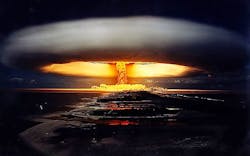DTRA asks industry for new kinds of sensors to detect and characterize nuclear weapons
Officials of the Defense Threat Reduction Agency (DTRA) at Fort Belvoir, Va., issued a broad agency announcement (HDTRA1-17-NTD-BAA) on Thursday for the New Initiatives for Nuclear Detection and Monitoring and Verification Technologies program.
DTRA researchers particularly are interested in enabling technologies for radiation imaging; search and localization; upstream detection; non-permissive environments; computer vision; vehicle and material tracking; and explosive depth in mountainous topology.
Radiation imaging involves solutions for fast and thermal gamma-ray and neutron radiation imaging, as well as radiation imager data exploitation.
Search and localization involves solutions to enable rapid detection, localization, and preliminary identification of special nuclear material in vehicles, on people, underwater, and in shipping containers.
Related: Russian unmanned underwater nuclear weapon raising the stakes in global balance of power
Upstream detection involves ways to detect and characterize trace amounts of weaponized portable and ruggedized nuclear materials.
Non-permissive environments involves solutions for remotely detecting, locating, and characterizing nuclear materials with tagging and tracking sensors, remote leave-behind sensors, and sensor payloads for unmanned vehicles.
Computer vision involves using computer vision to detect, identify, and track authorized and unauthorized nuclear materials in transit.
Vehicle and material tracking involves non-computer-vision-based solutions for the detection, identification, and tracking of authorized and unauthorized transportation of weapons and materials.
Explosion depth in mountainous topology involves technical methods for remote determination of the depth of explosions in mountainous topology.
Related: IED hunters adapt to sophisticated threats
Companies interested should submit quad charts and white papers no later than 14 July 2016 to the DTRA submission Website at www.dtrasubmission.net. Companies with promising white papers will be invited to submit formal proposals, which are due no later than 3 Oct. 2016.
Email questions or concerns to DTRA at [email protected].
More information is online at https://www.fbo.gov/spg/ODA/DTRA/DTRA01/HDTRA1-17-NTD-BAA/listing.html.
